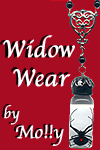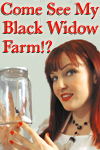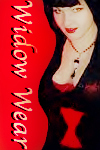
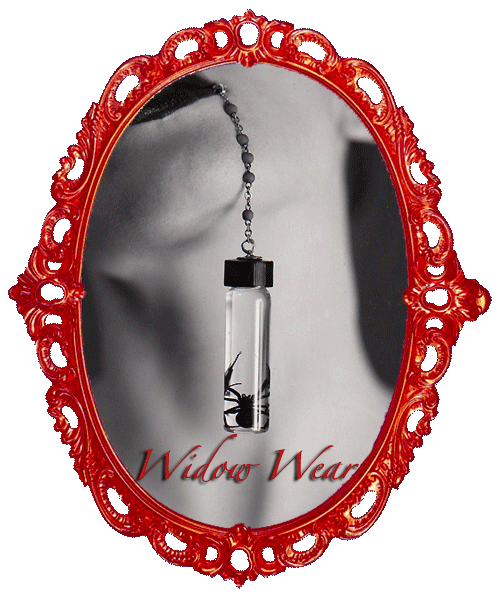
Music by: Joey Deluxe
WELCOME!!! I'm working hard at puttting together an even better site than used to be here! I hope to be adding all my photos of past and currently-available-for-adoption black widow spiders, the newest necklaces I've made for others, a REALLY-thorough spider FAQ, and even VIDEOS of my little darlings! Thanks for your patience and for spying on me!!! Check out what I have now and come back soon! |
Widow Wear Intro Video COMING SOON!!! |
MY STORY! My interest in spiders exploded in 1994, when I found a small, male Western Black Widow (Latrodectus mactans) on his fruitless quest to find a mate. I took him in and gave him a warm, safe, and food filled couple of months until Mother Nature took his tiny life back. Since that experience, I've raised well over 10,000 widows and enjoyed another 100 tarantulas of various species. My goal throughout this seemingly strange hobby is to become the foremost authority on the Latrodectus mactans, Latin for "murderous biting robber." Seeing these amazing creatures in all their stages of life has been a wonderful thrill for me and I'm pleased to be able to share it now through my unique custom black widow jewelry line, Widow Wear!!! |

As you will see in these pictures, the necklaces I've made can vary quite a bit, but the spider's display remains relatively constant. Custom work is certainly available and encouraged. I make each necklace and raise each widow myself from start to finish. Each spider comes with the spider's hatch date, death date, sex, and breeding status because they are from my own personal captive collection of black widow pets and I've have gone to great pains to collect and keep all pertinent records! Generally, I choose to work with leather, silver, glass beads, and blessed Catholic rosary bead chain. How gothic!! I also look forward to using custom material suggested or sent to me for your personal order. Spiders are available without necklaces, but at nearly the same price, as it's the spider that eats up most of the cost -- quite literally! |

VIAL VITALS The process of preparing them for their eternal display is difficult but rewarding. In their lifetime, a female black widow will shed 7-9 times and a male only 5-7 times. It is after this last shedding, when the exoskeletons of these spiders are the largest they will ever get, that they are fed once more to a attain a respectable girth and sent on the adventure of a lifetime, ending in a watery tomb in one of my necklace vials, for you to forevermore enjoy it's deadly beauty! In these vials, you can see every side of your spider specimen. They naturally stay at the bottom of the vial, standing on their back legs as it were, but without jeopardizing the pose of the spider, you can make your spider slide from bottom to top by inverting the vial -- like those floating pens of yesteryear! My customers love the heightened reality that the spider is REAL and JUST on the other side of the glass! These necklaces give cold chills to even the mildly arachnophobic and are a world more exciting then the childproof version where the bug is locked safely away in impervious preschooler plastic. The spiders used in my jewelry are not idiot proof. They are complete specimens with their poison glands and fangs perfectly intact. Just as you could accidentally inject yourself with the poison of a dead rattlesnake by stepping on it's head or otherwise piercing your skin with the fangs to naturally release it's toxins, you could, in theory, receive the venom of these black widow spiders. For your safety, leave the vial sealed. Please don't test fate. Mother Nature always wins. If your vial should somehow break or come unscrewed (impossible with normal use), take great caution in protecting your hands with thick gloves and dispose of the spider as you would a razor blade, by scooping it up with a piece of cardboard or similar material into a milk carton, sealed jar, or other protective container before putting it in the trash. Flushing the spider down the toilet could certainly work too. The liquid inside is harmless, but if possible, should be cleaned up wearing household gloves and using disposable paper towels and everything, gloves included, carefully thrown in the garbage afterward. "Better safe than sorry" is way I've always approached the handling of these potentially deadly creatures. |
WHAT MAKES MINE THE BEST??? I am not buying these specimens from some inbreeding dealer (as if there were one!). Each spider takes 1-2 years of my personal care before it can become a cherished piece of wearable widow art. I choose to offer them at their cost to me only to reimburse my effort and further my research. I have seen other "widow jewelry" go for as much as $750 for a horribly inferior bracelet of Tijuana silver and plastic, $350 for a tiny necklace hanging on a cheap leather cord without a clasp (for that much, you'd think you wouldn't have to wear some knot tied behind your head) and $450 for mismatched earrings (all still sitting in dust at a boutique in Hollywood). Those spiders were small, brown, withered, and encased in some form of lucite or plexiglass like a cheap truck stop scorpion keychain. The ever-important hourglasses were even hidden by the unnecessarily opaque backing and most importantly, they had NO idea where they came from, how old they were, how long they'd been dead, or any of the information that I find vital to the individuality of my product. One customer called the decision a "no brainer." Thank you, I agree! |
HOW CAN YOU GET ONE??? The response has been so overwhelming that I have a list of Widow Wear enthusiasts waiting for their adopted pets to grow large enough to use. Please don't let that take away the excitement that you could have one too. Orders, inquiries, comments, and special orders can all be done by e-mailing me at Molly(AT)MollyBrenner.com I will personally go through the whole process with you, tell you what's available, and address any of your questions. It's always best to be put on the waiting list ASAP. I work on a first-come-first-served basis!! There is NO money exchanged until I ship, so the list is FREE. At this time, I accept checks and money orders via snail mail, credit cards and e-checks though Paypal.com, and ship as soon as the payment clears. Free insured shipping in the US. |
CAN YOU SEE THEM IN PERSON??? The spiders? I do stock our very own Los Angeles Natural History Museum with their black widows and other assorted spiders when I find something Insect Zoo Coordinator Brent Karner just HAS to see! The necklaces? Sometimes! Because of the custom nature and high demand of my necklaces, the only place to see or purchase Widow Wear is through my site HERE, but I have gladly had my necklaces in shops near and far when the waiting list dies down! If you are a shop, don't hesitate to inquire, and if you have and are waiting, thank you SO much for your interest -- I will certainly let you know! |
HOW LONG DO THE NECKLACES LAST??? When you are ready to place your order, I usually work with you to perfect the necklace so that the moment your personal widow finally reaches their growth potential, it's all ready to ship! I "transform" them moments before shipping to you so that I can get you the freshest specimen possible, because like a rose, the spider's beauty can be preserved at length, but is most true while fresh! (Another reason I prefer to ship direct to YOU!) The oldest preserved widow I have in my home is over 12 years old. The liquid is still clear although about 5% has evaporated. The spider is totally intact without any sign of decomposition. The only difference between that spider and one a dozen years fresher is that the red hourglass washed out to a cream color, and the abdomen is getting a bit transparent (you thought they were creepy on the outside -- you should see the inside!!). Not bad for a spider over a decade dead!!! |
WHERE DO I GET THE SPIDERS??? Of the widows I have growing and breeding now, most of them came from the safety of their mom's eggsac; spun and hatched under my curious eye until years later when their miraculous lifespan comes to an end; which is why each one of my pieces comes with all of the spider's individual statistics. From time to time, I also get calls from friends standing on chairs, clinging to their brooms, and shrieking, "Come get it, Molly! It's HUGE!!" In those cases, I'll do my best to rescue the spider from the scared homeowner's can of Raid and introduce it to my colony of comfort! |
HAVE I EVER BEEN BITTEN??? That is the question I am asked most. Even now, I have to laugh at such a silly question. These are highly venomous creatures that require my caution, knowledge, and respect. Though modern hospitals carry the black widow antivenin, it's not something I care to experience ever because of the toxicity and impact of it's potentially deadly bite. I have never directly touched one of my black widow spiders. I use a combination of protective gear, specialized medical instruments, and my extensive experience and behavioral knowledge to keep them as far away from me as possible while cleaning and caring for them. And you thought I let them walk across my face or snuggled with them at night... Generally, widows are reclusive and will avoid anything they can't overpower. Only in an emergency, like when you nearly step on one or accidentally squish one in your sleep with they stop fleeing and use their powerful venom (15 times as potent as a rattlesnake) in defense. |
WHAT DO THEY EAT??? Even in nature, the widow's lives are spent almost entirely on their small web. They use up very little oxygen and energy while they wait for something tasty to happen by. Spiders are very sensitive to poison, so I never feed my pets any household bugs which could have been exposed to a number of chemicals before being found. My black widows thrive mostly on factory farm raised crickets and other small insects, although some of the more aggressive ones have enjoyed everything from praying mantids, pinkie mice, to each other! Why would I feed these precious spiders to each other? When black widow spiderlings are born, their blonde bodies are the size of a poppy seed which presents a challenge in offering small enough insects for it to eat. At this point (and because each eggsac has from 25-300 spiderlings and a recorded case of almost 3,000 in 1934!) I've been allowing them to do as they do in nature, to eat each other until they shed their way to an easier size. Even the mother will snack on them if you let her, so after mom is finished making her eggsac (which looks a bit like a garbanzo bean), it is taken away to the safety of a sealed incubation jar. |
HOW DO THEY GROW??? Because arachnids have an exoskeleton, in order to grow, they shed the old outer layer to reveal an elastic inner layer which expands to a larger size and quickly hardens, forming the new skeleton. The molting process in an adult widow only takes about an hour. When the new elastic layer just gets exposed, it's almost clear in color. In just a few hours, the new cuticle regains it's original black pigment and strength and the spider is bigger and better then ever! |
WHAT'S THE DIFFERENCE BETWEEN MALE AND FEMALE??? The male widows retain their youthful tan and black colored tiger stripes, have a yellow to orange hourglass, and are easily a third of the size of their black and red female companions. When they reach sexual maturity, you can easily see that the pedipalps (the tiny leg-like appendages located between the front legs and the fangs) of the male have engorged with the sperm they take from their own genitals and hold here for mating. After reaching sexual maturity, with or without mating, males don't have long to go before their demise, but females can live far beyond mating -- sometimes producing as many as 9 eggsacs before death or depletion. Can you imagine a species so intent on survival that it only needs to mate one time to produce offspring for the rest of their lives? |
HOW DO THEY REPRODUCE??? The mating process is a delicately dangerous one for the male black widow spider. Sexually mature males get much more active and will leave their webs in search of a female. Despite their eight eyes, these spiders are nearly blind and rely on their sense of touch to survive. Just by the female's web, the male can sense if she ready to mate. If the male just walks right into the web without caution, he will surely become the female's next meal. Instead, he waits on the outside edge of the female's web and use's his abdomen in a rhythmic dance that amazingly sedates the naturally aggressive female into a reciprocal vibration, allowing the male to get closer. If she is not ready, she may just falsely lure him into her web to eat him! You go, girl! If she is ready, she will allow him to come closer, tie her up in a loosely constructed web (ALA spider bondage), and sneak in those engorged pedipalps into her genital opening. When they are done with this ritual, she easily breaks free of this wimpy web and will usually let him run off to brag to his friends (just kidding -- widows are anything but social). Only if she is starving will she make a meal out of this hard working male, hence the given name "widow," but that situation isn't in the majority of cases in nature or in my well fed girls! |
HOW LONG DO THEY LIVE??? The black widow reaches maturity in as little as one year or take over two years, depending on the temperature, availability of food, and space. I keep my black widows warm, fed, and in enormous individual castles, but there still isn't a method to make them grow any faster then nature intended. Even under the best possible conditions, I can only supply a very limited amount, therefore each necklace is a rare treat, symbolizing years of my care and knowledge. |
LASTLY??? Thank you so much for your interest in me, my hobby, and my product. These little creatures have given me years of inspiration and pleasure I hope I conveyed with this simple site and my unique necklaces. |
Mo!!y
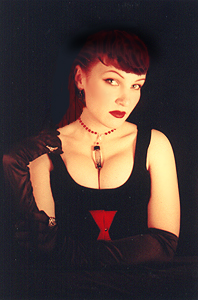
Again, for my general Spider Spam, waiting list, and ordering info, email me @ Molly(AT)MollyBrenner.com!!! |
LINK ME!!!
